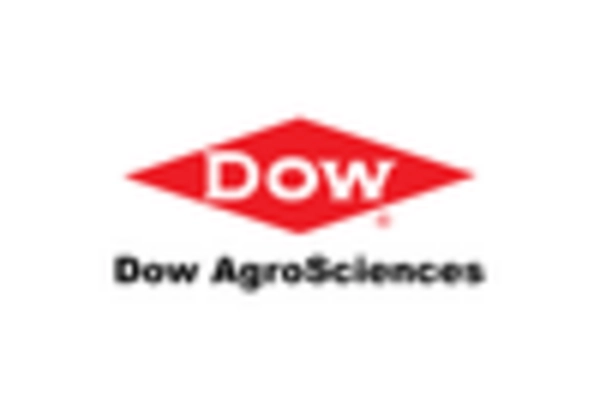Support from Agricultural Policies
Supportive agricultural policies aimed at promoting sustainable farming practices are playing a crucial role in the growth of the bioherbicides market. Government initiatives that encourage the use of environmentally friendly agricultural inputs are fostering an environment conducive to the adoption of bioherbicides. These policies often include financial incentives, research funding, and educational programs that inform farmers about the benefits of bioherbicides. As a result, the bioherbicides market is likely to experience accelerated growth, with estimates suggesting an increase in market penetration by 20% over the next few years as more farmers take advantage of these supportive measures.
Rising Costs of Chemical Herbicides
The escalating costs associated with chemical herbicides are prompting farmers to explore more cost-effective alternatives, thereby benefiting the bioherbicides market. As the prices of synthetic herbicides continue to rise, driven by factors such as supply chain disruptions and regulatory changes, farmers are increasingly turning to bioherbicides as a viable solution. This shift not only helps in reducing input costs but also aligns with the growing trend towards sustainable agriculture. The bioherbicides market is expected to capitalize on this trend, with an estimated market value reaching $1 billion by 2027, as more farmers recognize the economic advantages of adopting bio-based solutions.
Advancements in Research and Development
Advancements in research and development within the agricultural sector are significantly impacting the bioherbicides market. Ongoing innovations in the formulation and application of bioherbicides are enhancing their effectiveness and broadening their applicability. Research institutions and private companies are investing in the development of new bioherbicide products that target a wider range of weeds while minimizing adverse effects on crops. This focus on R&D is expected to drive market growth, with projections indicating that the bioherbicides market could expand by 18% annually as new products enter the market and gain acceptance among farmers.
Consumer Preference for Organic Products
The increasing consumer preference for organic products is significantly influencing the bioherbicides market. As more consumers prioritize health and sustainability, the demand for organic produce is on the rise. This trend is encouraging farmers to adopt bioherbicides as part of their cultivation practices to meet consumer expectations. The bioherbicides market is likely to benefit from this shift, with market analysts projecting a growth rate of approximately 12% over the next five years. This consumer-driven demand is pushing agricultural producers to seek out bioherbicide solutions that align with organic farming standards, thereby expanding the market's reach.
Increasing Awareness of Environmental Impact
The growing awareness of the environmental consequences of synthetic herbicides is driving interest in the bioherbicides market. Consumers and farmers alike are becoming more conscious of the ecological footprint of agricultural practices. This shift in perception is leading to a preference for sustainable alternatives that minimize harm to ecosystems. As a result, the bioherbicides market is witnessing a surge in demand, with projections indicating a potential growth rate of around 15% annually. This trend is particularly pronounced in regions where organic farming is gaining traction, as farmers seek to align their practices with consumer expectations for environmentally friendly products.

















Leave a Comment